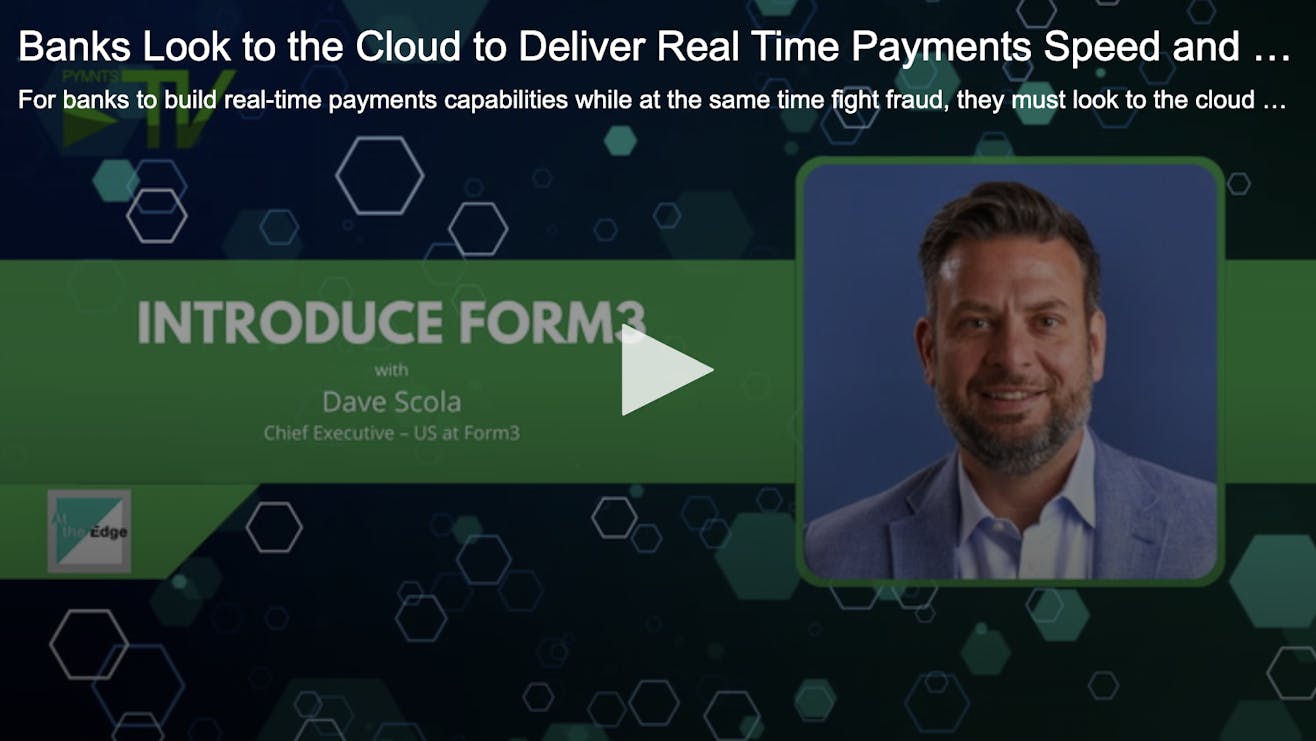Banks Look to the Cloud to Deliver Real Time Payments Speed and Security
Thought Leadership· 5min June 9, 2023
As real-time payments schemes take root around the world, financial institutions must grapple with new operational and technical challenges. Dave Scola, U.S. CEO for Form3, told PYMNTS that the issues are now front and center — and payments as a service can help alleviate pain points.

“All banks need to connect to payment rails across the world. Those payment rails are complex and require a lot of maintenance.”
And beyond the technical considerations tied to those rails, said Scola, the standards governing those rails, in terms of security and compliance, can change often and differ from region to region.
With all those challenges in place, he said, banks need a simpler and streamlined way to connect to those rails.
A cloud-based platform approach lets banks outsource those functions. He said that through a single set of codes and application programming interfaces (APIs), Form3 gathers the data needed to generate and move payments to settlement. Then it sends confirmation back to the platform’s clients.
The model’s been tested — 40% of the faster payments traffic through the U.K. moves across Form3’s platform. In recent months, the company’s been expanding its reach to include the U.S., where Form3 has been building out its capabilities around FedNow, TCH’s RTP® network and Fedwire.
Realizing the Limitations
The banks themselves, he said, have been realizing the limitations of their proprietary solutions and legacy systems that have been built over decades. The older technologies had been good enough to handle payments functions until the last couple of years.
“But now bank clients are demanding more flexibility and higher levels of services. The banks want to address those demands but are now looking at the hulking dinosaurs of their legacy platforms and trying to figure out how they can accommodate those demands.”
The urgency to do so is underscored by the rise of real-time payments — which demand that transactions be processed in a matter of seconds, 24/7.
The cloud-based connectivity, he said, helps serve as an always-up-to-date last mile that ensures banks can satisfy their clients’ needs and the demands of real-time payments, especially as the industry migrates to data-rich ISO 20022 messaging standards.
The API approach allows the flexibility to accommodate multiple different messaging formats — not only ISO 20022 but also the legacy Fedwire Application Interface Manual (FAIM) messaging in the U.S. For banks’ developers, utilizing the APIs is different than hard coding traditional message format — where once those formats are coded, they become embedded in the backend programming languages payment flow and are notoriously difficult to change.
“Once you are integrated into that API, you can then access basically the entire suite of services that we offer, whether in the U.K., Europe — and whether it’s payment orchestration or fraud prevention.”
Inherent in the shift to faster payments is the specter of faster fraud. FIs have to conduct anti-money laundering (AML) checks, verify funds availability and check if the account on the other end of the transaction is a valid recipient. With the legacy systems in place, those tasks are almost impossible to complete in near-real-time.
“As the client maintains connectivity through us — and through the API — we can handle that change management aspect, and we do it on behalf of all of our clients as part of the service,” said Scola.
Asked by PYMNTS whether there’s been the need to educate banks and CIOs on the benefits of a cloud-based approach to payments rail-connectivity, Scola noted that “if I had gone to a bank seven years ago and pitched moving their payments to the cloud, I might have been laughed out of the room.”
“But now we’ve seen banks and CIOs become increasingly more comfortable with the use of what is effectively just an outsourced technical infrastructure … it’s an easier conversation to have today.”
Looking ahead, Scola noted that financial systems ecosystems are evolving, driven by payments as a service. And for Form3, he said, there’s particular value in bringing a comprehensive, fraud-fighting approach to that market.
“Meeting the needs tied to creating a real-time payments environment is going to be a massive challenge for most banks,” he said. “No single institution can solve these challenges on their own.”
Originally published on PYMNTS.com
Written by
Dave joined Form3 in 2022 in order to lead the charge to bring Form3’s platform and capabilities to bear on the US market.
Dave has worked in transaction banking for over 20 years and has joined Form3 from SWIFT where he was Chief Executive for the Americas, UK and Ireland with responsibility for the company’s largest relationship as well as its global securities business.
Prior to SWIFT, Dave was the Global Head of Financial Institutions at Barclays, responsible for the bank’s correspondent banking, FI trade, flow FX, and liquidity management businesses for FIs.
He has also worked at Deutsche Bank and Bank of New York in both product and strategy roles and across various products lines including cash, trade finance, custody and corporate trust.
Dave holds a MSc in Development Economics from the School of Oriental and African Studies in London, and a BSFS in International Relations from Georgetown University.









 Back to News
Back to News

